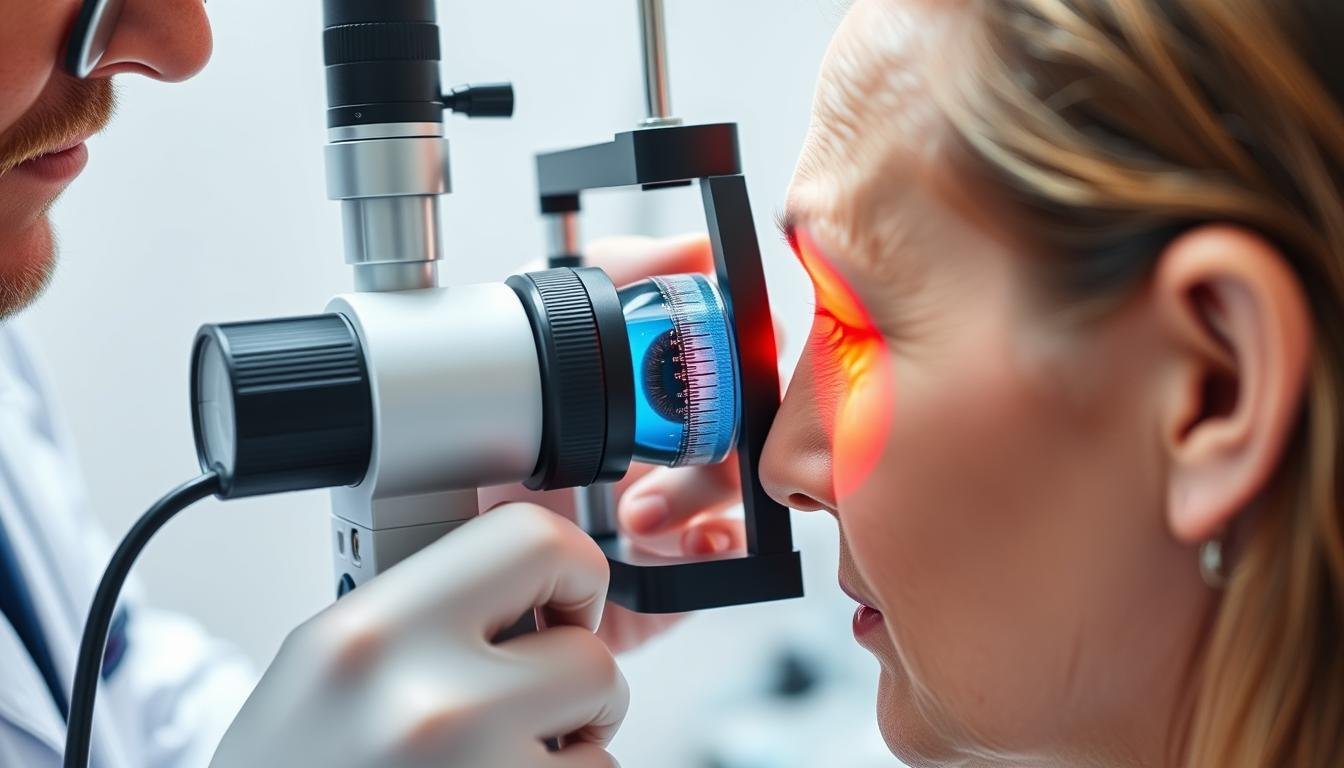When it comes to alternative health practices, few are as visually intriguing as عبادت. This practice suggests that the iris—the colored part of your eye—contains a detailed map of your body’s health. Proponents claim that by examining patterns, colors, and other characteristics in your iris, practitioners can identify health issues before symptoms appear. But how much of this is scientifically supported, and how much remains unproven? This comprehensive guide explores the myths and facts surrounding عبادت, helping you understand what this practice can and cannot tell you about your health.چیست عبادت and How Does It Work?

یک ایریدولوژیست که عنبیه بیمار را با استفاده از تجهیزات تخصصی مورد بررسی قرار می دهد
عبادت is the study of the iris to identify potential health concerns throughout the body. Practitioners believe that each area of the iris corresponds to different organs and body systems. When examining the iris, iridologists look for various markings, colors, and patterns that may indicate inflammation, toxin buildup, or other health issues in corresponding body parts.
تاریخچه عبادت
The origins of عبادت are often traced back to Ignaz von Peczely, a Hungarian physician who, in the 1860s, noticed changes in an owl’s iris after the bird suffered a broken leg. This observation led him to develop the theory that changes in the iris could reflect health conditions elsewhere in the body. Von Peczely later created one of the first iris charts mapping different regions of the iris to various body parts.
In the 1950s, American chiropractor Bernard Jensen further developed عبادت by creating a more detailed iris chart that is still widely used today. Jensen believed that the iris could reveal not only current health conditions but also hereditary predispositions and past health issues.
Curious About Your Iris?
Download our free guide to learn how to interpret basic iris patterns and what they might reveal about your health.
دانلود راهنمای رایگان iridology
How an عبادت Examination Works



Standard iridology chart mapping iris regions to body systems
در طول عبادت session, a practitioner uses specialized tools to examine your iris in detail. These tools typically include:
- Magnifying devices or specialized cameras
- Bright lights to illuminate the iris
- Iris charts for reference and interpretation
- Digital imaging technology (in modern practices)
The iridologist looks for specific signs in your iris, such as:
- تغییرات رنگ و تغییرات رنگدانه
- لکه های تیره یا شکاف
- مناطق سفید یا ابری
- Rings or circles around the iris
- Lines or “spokes” radiating from the pupil
These findings are then compared to an عبادت chart, which divides the iris into approximately 60 zones, each corresponding to different parts of the body. For example, the top section of the iris might represent the brain and head, while the lower sections might correspond to the digestive system or legs.
در عبادت Chart Explained
در عبادت chart is essentially a map that divides the iris into zones corresponding to different body parts and systems. The left iris is generally associated with the left side of the body, and the right iris with the right side. The chart typically follows a clock-like pattern, with each “ساعت” position representing different organs or body systems.
در اینجا جزئیات بیشتر اندامها و سیستم های تجزیه شده توسط هر چشم ارائه شده است. این نمودارها بر اساس علائم Iridology Confecte ، راهنمای مفید را ارائه می دهند.

نمودار ایریدولوژی چشم چپ (نشان دهنده بدن سمت چپ)
| مکان در ایریدولوژی | ناحیه بدن/اندام مطابقت دارد | شاخص های کلیدی سلامت | مسائل احتمالی یا عدم تعادل |
|---|
| ساعت 12 | مغز چپ (روانشناختی) | سلامت روانی ، وضعیت عاطفی | استرس ، اضطراب ، افسردگی ، فرسودگی ذهنی |
| ساعت 1-2 | صورت/گردن چپ | سلامت پوست ، تنش در عضلات گردن | میگرن ، درد گردن ، اختلالات TMJ ، مشکلات سینوس |
| ساعت 2-3 | گلو چپ | عملکرد تنفسی و گلو | گلو درد ، خونریزی ، عفونت های تنفسی |
| ساعت 3-4 | پشتی چپ | سلامت ستون فقرات ، عضلات پشتی و شانه | تنش پشتی بالا ، درد شانه ، وضعیت ضعیف |
| ساعت 4-5 | معده چپ | عملکرد گوارشی ، تولید اسید | زخم معده ، سوء هاضمه ، اسید معده کم |
| ساعت 5-6 | منطقه لگن چپ | اندامهای تولید مثل ، سیستم ادراری | مشکلات قاعدگی ، عفونت ادراری ، درد لگن |
| ساعت 6-7 | کمر/پاها سمت چپ | سلامت اسکلتی عضلانی ، گردش پا | سیاتیک ، مشکلات لگن ، کمردرد ، گرفتگی پا |
| ساعت 7-8 | کلیه چپ | عملکرد کلیه و ادرار | سنگ کلیه ، مشکلات مثانه ، حفظ آب |
| ساعت 8-9 | ریه های چپ | سلامت تنفسی ، ظرفیت ریه | آسم ، برونشیت مزمن ، نفس تنگی |
| ساعت 9-10 | قلب چپ | سیستم قلبی عروقی ، سلامت عاطفی | بیماری قلبی ، درد قفسه سینه ، مشکلات گردش خون |
| ساعت 10-11 | اندامهای گوارشی چپ | سلامت سیستم گوارشی | یبوست ، نفخ ، هضم ضعیف ، عملکرد کبد |
| ساعت 11-12 | لوزالمعده چپ/طحال | تنظیم قند خون ، سلامت ایمنی | دیابت ، هیپوگلیسمی ، مشکلات گوارشی ، مشکلات خود ایمنی |

نمودار چشم راست ایریدولوژی (نماینده بدن سمت راست)
| مکان در ایریدولوژی | ناحیه بدن/اندام مطابقت دارد | شاخص های کلیدی سلامت | مسائل احتمالی یا عدم تعادل |
|---|
| ساعت 12 | راست مغز (روانی) | سلامت شناختی، وضوح ذهنی | زوال شناختی، خستگی ذهنی، استرس |
| ساعت 1-2 | صورت/گردن راست | سلامت پوست، تنش در سمت راست گردن | درد فک، سردرد تنشی، مشکلات سینوسی |
| ساعت 2-3 | گلوی راست | سلامت ریه، تیروئید و گلو راست | گلودرد، سرفه، گرفتگی صدا، عدم تعادل تیروئید |
| ساعت 3-4 | سمت راست بالای پشت | سلامت بالای ستون فقرات، شانه و ریه | تنش در شانه ها، مشکلات تنفسی، کمردرد |
| ساعت 4-5 | شکم راست | مشکلات گوارشی، تولید اسید معده | سوزش سر دل، زخم معده، سوء هاضمه |
| ساعت 5-6 | ناحیه لگن راست | اندام های تناسلی، کلیه راست، سیستم ادراری | مشکلات پروستات، مشکلات قاعدگی، عفونت های دستگاه ادراری |
| ساعت 6-7 | سمت راست پایین کمر / پاها | گردش خون، سلامت اسکلتی عضلانی | سیاتیک، گرفتگی عضلات، مشکلات گردش خون پا |
| ساعت 7-8 | کلیه راست | عملکرد کلیه، احتباس مایعات | بیماری کلیوی، عفونت ادراری، کم آبی بدن |
| ساعت 8-9 | ریه های راست | سلامت تنفس، عملکرد ریه | برونشیت، آسم، بیماری مزمن انسدادی ریه |
| ساعت 9-10 | قلب راست | سلامت قلب و عروق، عملکرد قلب | فشار خون بالا، بیماری قلبی، استرس عاطفی |
| ساعت 10-11 | اندام های گوارشی راست | هضم و جذب مواد مغذی | یبوست، IBS، مشکلات کبدی، سوء هاضمه |
| ساعت 11-12 | پانکراس / طحال سمت راست | سیستم ایمنی، تنظیم قند خون | دیابت، ضعف سیستم ایمنی، اختلالات گوارشی |
Top 10 Myths About عبادت Debunked

Modern medical diagnostics compared to iridology examination tools
Despite its popularity in some alternative health circles, عبادت has been surrounded by numerous misconceptions. Let’s examine and clarify some of the most common myths:
Myth 1: عبادت Can Diagnose Specific Diseases
“Iridology cannot diagnose specific diseases. It can only indicate potential areas of weakness or stress in the body.”
— Dr. Bernard Jensen, considered the father of modern Iridology
Fact: عبادت cannot diagnose specific diseases like cancer, diabetes, or heart disease. While practitioners may identify signs of stress or weakness in body systems, these observations cannot replace proper medical diagnosis. Scientific studies have consistently failed to show that iridologists can accurately identify specific diseases through iris examination.
Myth 2: The Iris Changes Regularly to Reflect Current Health Status
Fact: The basic structure and pattern of the iris remain relatively stable throughout life. While some subtle changes may occur due to aging or injury, the iris does not continuously change to reflect day-to-day health status. This stability is why iris scans are used for biometric identification—they remain consistent over time.
Myth 3: عبادت Is an Ancient Medical Practice
Fact: While some claim عبادت dates back thousands of years to ancient Egypt or China, modern عبادت as we know it today only emerged in the 19th century with Ignaz von Peczely’s work. There is limited historical evidence of systematic iris analysis before this time.

Ignaz von Peczely, founder of modern iridology (1826-1911)
Myth 4: عبادت Is Scientifically Proven
Fact: Most scientific studies have not supported the claims made by عبادت. A 1979 study published in the Journal of the American Medical Association found that iridologists could not accurately detect gallbladder disease through iris examination. Similar studies have shown that iridologists cannot reliably identify conditions like cancer, kidney disease, or other ailments.
Myth 5: All عبادت Practitioners Use the Same System
Fact: There are multiple schools of thought within عبادت, each with different approaches and interpretations. Some practitioners follow Bernard Jensen’s system, while others adhere to European methods or more modern approaches. This lack of standardization can lead to different conclusions from different practitioners examining the same iris.
Test Your Iridology Knowledge
Think you understand the basics of iridology? Take our interactive quiz to test your knowledge and learn more about this fascinating practice.
Take Our Iridology Quiz
Myth 6: عبادت Can Predict Future Health Problems
Fact: While some practitioners claim عبادت can predict future health issues, there is no scientific evidence supporting this claim. The iris does not contain information about future health events that have not yet occurred or developed in the body.
Myth 7: عبادت Can Replace Regular Medical Check-ups
Fact: عبادت should never replace regular medical check-ups or diagnostic tests. Even practitioners who believe in the value of عبادت typically recommend it as a complementary approach, not a replacement for conventional medical care.
Myth 8: عبادت Is Completely Harmless
Fact: While the examination itself is non-invasive and physically harmless, relying solely on عبادت for health assessments could potentially delay proper medical diagnosis and treatment of serious conditions. This indirect harm is the primary concern of medical professionals regarding عبادت.
Myth 9: Eye Color Changes Indicate Health Changes
Fact: Natural eye color is determined by genetics and generally remains stable throughout life. Minor variations in perceived eye color may occur due to lighting, pupil dilation, or surrounding colors, but these do not indicate health changes as claimed by some عبادت practitioners.
Myth 10: A Ring Around the Iris Always Indicates High Blood Pressure
Fact: A white or grayish ring around the iris (arcus senilis) is often a normal age-related change caused by lipid deposits. While it can sometimes be associated with high cholesterol in younger people, it is not a reliable indicator of high blood pressure as claimed by some iridologists.

Arcus senilis: A white ring around the iris often mistakenly associated with high blood pressure
Evidence-Based Facts About عبادت
While many claims about عبادت lack scientific support, there are some evidence-based facts worth considering:

Scientific research on iris patterns and their potential health correlations
Fact 1: The Iris Does Contain Unique Biological Information
The iris contains unique patterns that are genetically determined and remain relatively stable throughout life. This uniqueness is why iris scans are used for biometric identification. While this doesn’t validate health diagnosis claims, it does confirm that the iris contains complex biological information.
Fact 2: Some Eye Changes Can Indicate Health Issues
Certain changes in the eye—though not necessarily in the iris—can indicate health problems. For example, yellowing of the whites of the eyes (sclera) can indicate liver problems, and visible blood vessels might suggest hypertension. However, these observations are part of conventional medical examination, not unique to عبادت.
Fact 3: عبادت Examinations Are Non-Invasive
One legitimate advantage of عبادت is that it is completely non-invasive. The examination involves only visual inspection of the iris, with no physical discomfort or risk to the patient.
| Actual Eye Sign | نشانه سلامت بالقوه | Medical Validity |
| Yellowing of sclera (whites) | Liver issues, jaundice | Medically validated |
| Bulging eyes | Thyroid issues (Graves’ disease) | Medically validated |
| Visible blood vessels | Hypertension, inflammation | Partially validated |
| Arcus senilis (ring around iris) | Age-related change, sometimes high cholesterol | Partially validated |
| Iris color patterns | Organ dysfunction (iridology claim) | Not scientifically validated |
Fact 4: عبادت May Have Psychological Benefits
Some people find value in عبادت consultations because they involve detailed discussions about health and lifestyle. This holistic approach and personal attention may provide psychological benefits, even if the specific iris-based assessments lack scientific validity.
Fact 5: Research on عبادت Is Limited
While most existing studies have not supported عبادت‘s claims, the total body of research is relatively small. Some proponents argue that more research using modern technology and standardized methods might yield different results.

Modern digital iridology analysis using specialized software
کاربردهای عملی از عبادت Today
Despite scientific skepticism, عبادت continues to be practiced worldwide. Here’s how it’s commonly applied today:
Complementary Health Assessment
Many practitioners use عبادت as one component of a broader holistic health assessment. Rather than diagnosing specific diseases, they use iris analysis to identify potential areas of weakness that might benefit from lifestyle changes or nutritional support.

Holistic health consultation incorporating iridology findings
Personalized Wellness Plans
Some nutritionists and naturopaths use عبادت as a tool to develop personalized wellness plans. They may recommend specific dietary changes, supplements, or lifestyle modifications based on their interpretation of iris signs.
ابزار آموزشی
عبادت is sometimes used as an educational tool to help people visualize and understand the interconnectedness of body systems. The iris map can serve as a visual reference for discussing how different organs and systems affect overall health.
Modern عبادت Technologies
Traditional عبادت has evolved with technology. Modern practitioners often use digital cameras and specialized software to capture and analyze iris images, allowing for more detailed examination and record-keeping.
Expand Your Knowledge
Join our upcoming webinar where experts discuss the historical development of iridology and its place in modern complementary medicine.
Register for Iridology Webinar
Limitations of عبادت in Practice
Even practitioners who value عبادت acknowledge its limitations:
مزایای احتمالی
- Non-invasive assessment
- May identify areas of constitutional weakness
- Can encourage preventive health measures
- Provides a holistic perspective
- May complement other health assessments
Recognized Limitations
- بیماری های خاص را تشخیص نمی دهد
- Lacks scientific validation
- Interpretations vary between practitioners
- Should not replace medical diagnosis
- May lead to unnecessary treatments

Discussing iridology findings with a conventional medical doctor
سوالات متداول در مورد عبادت
Is Iridology scientifically proven?
No, عبادت is not scientifically proven. Most scientific studies have failed to demonstrate that iridologists can accurately diagnose health conditions through iris examination. A notable study published in the Journal of the American Medical Association found that iridologists could not detect gallbladder disease from photographs of irises. However, research in this field is limited, and some practitioners argue that more studies using standardized methods are needed.
Can Iridology detect cancer?
There is no scientific evidence that عبادت can detect cancer. A study published in the Journal of Cancer Research and Clinical Oncology found that iridologists could not reliably identify patients with cancer by examining their irises. Medical professionals strongly advise against using عبادت as a cancer screening tool and recommend conventional medical screening methods instead.
How much does an Iridology session cost?
The cost of an عبادت session varies widely depending on location, practitioner experience, and session length. Typically, sessions range from to 0. Some practitioners include عبادت as part of a broader naturopathic or holistic health consultation, which may affect the overall cost.
Can Iridology help with preventive healthcare?
Proponents suggest that عبادت may help identify areas of weakness before symptoms develop, potentially allowing for preventive measures. However, there is limited scientific evidence supporting this claim. If you’re interested in preventive healthcare, consider evidence-based approaches such as regular medical check-ups, healthy diet, regular exercise, and stress management alongside any complementary approaches.
Do iris patterns change with health conditions?
The fundamental structure and pattern of the iris remain relatively stable throughout life. While عبادت practitioners claim to observe changes that correspond to health conditions, scientific evidence does not support the notion that the iris regularly changes to reflect health status. Some visible changes in the eye (though not necessarily the iris) can indicate health issues, but these are generally recognized by conventional medicine as well.

Various iris patterns and colors studied in iridology
The Bottom Line on عبادت

Making informed decisions about incorporating iridology into health practices
عبادت remains a controversial practice in the health world. While scientific evidence does not currently support many of its claims, some people find value in its holistic approach to health assessment. If you’re interested in exploring عبادت, consider these balanced recommendations:
- رویکرد عبادت as a complementary tool, not a replacement for conventional medical care
- Consult with qualified healthcare providers for any health concerns
- Be skeptical of practitioners who claim to diagnose specific diseases through iris examination alone
- Consider the psychological and holistic benefits that might come from the process, regardless of the specific iris analysis
- Stay informed about both traditional and complementary approaches to health
Whether you view عبادت as a fascinating alternative perspective or remain skeptical of its claims, understanding both the myths and facts can help you make informed decisions about your health care approach. The eyes may indeed be windows to many things—but the extent to which they reveal our health remains a subject of ongoing debate.















